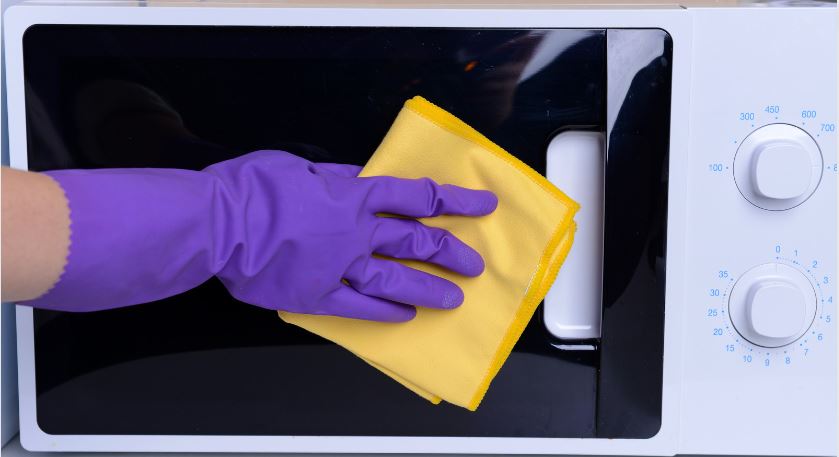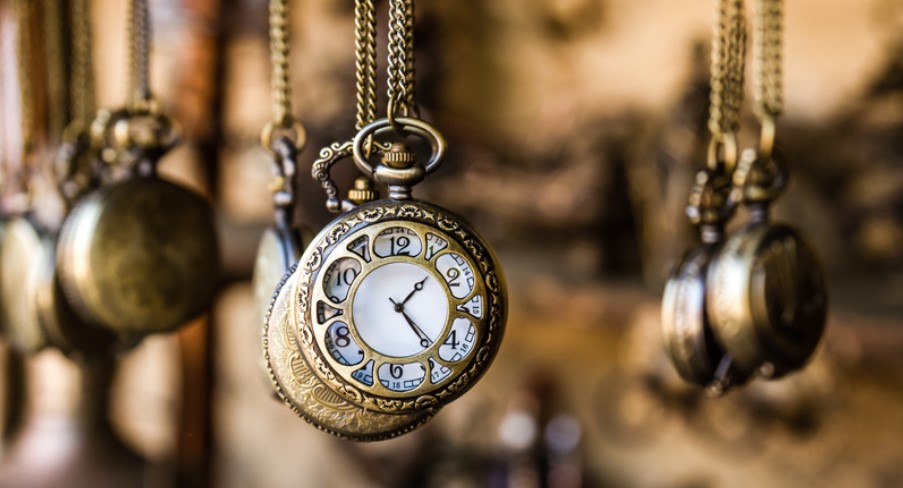To effectively clean hardwood floors and preserve their natural beauty, it is important to follow a comprehensive cleaning routine. Daily sweeping, regular vacuuming, and proper mopping techniques are key to maintaining the lustre of your wood floors. It is also essential to address scratches and scuffs promptly to keep your floors looking their best. By following these steps, you can ensure that your hardwood floors remain clean and beautiful for years to come.
Hardwood floors add elegance and warmth to any home. Whether you have solid wood or engineered hardwood floors, it is crucial to clean and care for them properly to ensure their longevity. Dust, dirt, and spills can all take a toll on your floors over time, causing wear and tear. To avoid this, a regular cleaning routine is recommended, comprising of daily maintenance, vacuuming, mopping, and addressing any scratches or scuffs that may occur. Let’s explore each of these steps in detail to help you understand how to clean hardwood floors effectively and efficiently.
How to Clean Hardwood Floors?
Daily maintenance is crucial for keeping hardwood floors clean. To maintain the natural beauty of your hardwood floors, it is essential to incorporate sweeping and dry mopping into your regular cleaning routine.
Start by sweeping the floors daily to remove dirt, dust, and other debris. Pay special attention to high-traffic areas like entryways and hallways, as these tend to accumulate more dirt. Using a soft-bristle broom or a microfiber dust mop, gently sweep in the direction of the wood grain to avoid scratching the surface.
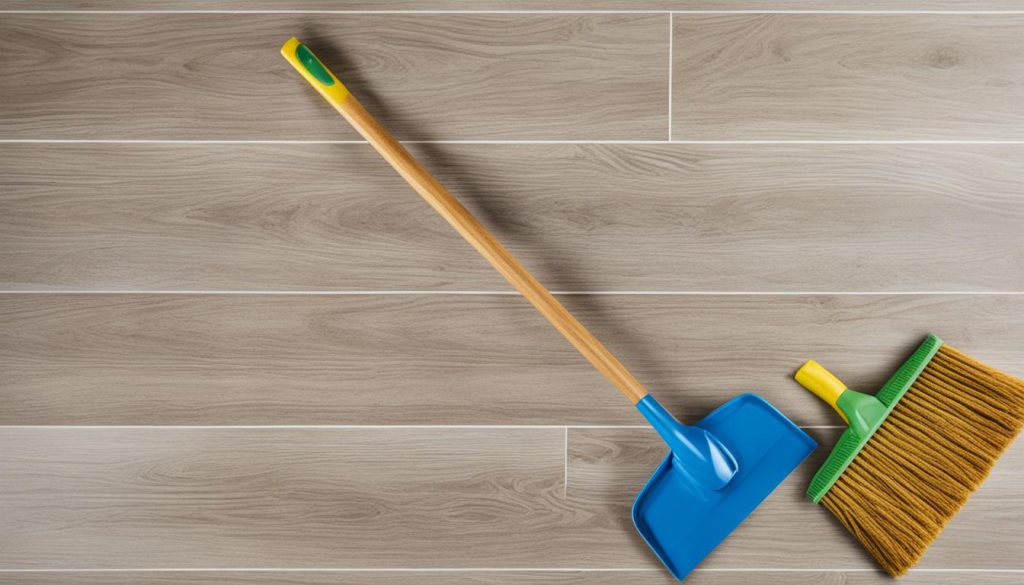
After sweeping, it is recommended to follow up with a dry mop or dust mop to pick up any remaining dirt or fine particles. A dry mop is designed to attract and trap dust, ensuring a thorough clean without the need for water. Opt for a microfiber mop, as it is gentle on hardwood floors and helps maintain their luster.
By incorporating daily sweeping and dry mopping into your cleaning routine, you can effectively remove dirt and debris, preventing them from scratching or dulling the surface of your hardwood floors.
Regular Vacuuming
In addition to sweeping, regular vacuuming is essential for maintaining the cleanliness of your hardwood floors. Vacuuming helps to remove fine particles and dust that may settle into cracks and crevices, ensuring a deep clean and prolonging the life of your hardwood floors.
When vacuuming hardwood floors, it is important to use a vacuum cleaner with a hard floor setting to prevent scratching the wood. Ensure that the brush roll or beater bar is turned off, or use a flat attachment specifically designed for hardwood floors to protect the delicate surface.
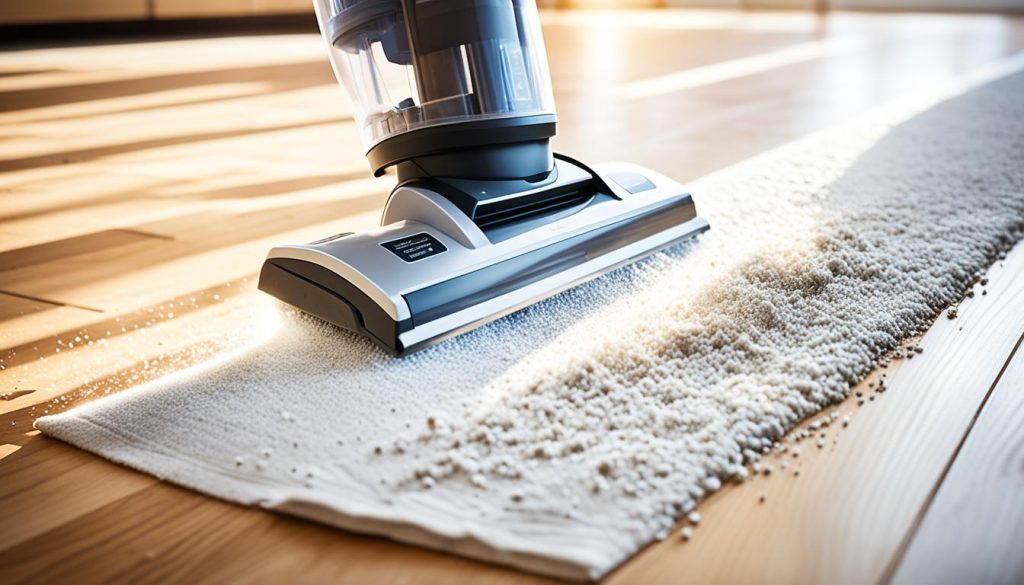
By gently gliding the vacuum cleaner across the floor, you can effectively remove dirt, pet hair, and other debris without causing any damage. Pay special attention to high-traffic areas and places near entrances where dirt and dust are likely to accumulate.
Vacuuming your hardwood floors regularly not only improves their appearance but also helps to maintain their overall condition. It reduces the need for extensive cleaning and prevents scratches caused by abrasive particles that may be present on the floor’s surface.
Top Tips for Vacuuming Hardwood Floors
- Choose a vacuum cleaner with a hard floor setting to avoid scratching the wood.
- Ensure that the brush roll or beater bar is turned off, or use a flat attachment designed for hardwood floors to protect the surface.
- Gently glide the vacuum cleaner across the floor, applying minimal pressure to avoid any potential damage.
- Pay extra attention to high-traffic areas and places near entrances where dirt and dust tend to accumulate.
- Regularly clean or replace the vacuum cleaner’s filters to maintain optimal performance and prevent dust from being redistributed.
Regular vacuuming is an essential step in maintaining the cleanliness and beauty of hardwood floors. By using a vacuum cleaner with the right settings and taking proper precautions, you can effectively remove dirt and dust, ensuring that your hardwood floors remain in pristine condition for years to come.
| Pros of Regular Vacuuming | Cons of Neglecting Vacuuming |
|---|---|
| Removes fine particles and dust, ensuring a deep clean | Accumulation of dirt and debris can cause scratches and wear |
| Helps maintain the overall condition of hardwood floors | Ineffective cleaning can lead to the appearance of dull and dirty floors |
| Reduces the need for extensive cleaning and maintenance | Increases the risk of allergens, dust mites, and pet dander |
Proper Mopping Techniques
Mopping is an essential step in maintaining clean and beautiful hardwood floors. However, it is crucial to follow the proper techniques to avoid damaging the wood. Here are some tips to help you mop your hardwood floors effectively:
- Use a wood floor cleaner: Choose a cleaning solution specifically formulated for hardwood floors. Avoid using harsh chemicals or abrasive cleaners that can strip away the finish or cause discoloration. Dilute the cleaner according to the manufacturer’s instructions.
- Use a damp microfiber mop: Microfiber mops are ideal for hardwood floors as they are gentle and effective at removing dirt and grime. Dampen the mop with the prepared cleaning solution, ensuring it is not soaking wet. Excess water can seep into the cracks and cause damage to the wood.
- Start from the farthest corner: Begin mopping from the farthest corner of the room and work your way towards the exit. This ensures that you don’t walk on the freshly mopped areas and leave footprints or smudges.
- Work in small sections: Divide the floor into manageable sections and focus on cleaning one section at a time. This allows you to thoroughly clean each area without the cleaning solution drying out before you can mop it up.
- Gently mop in straight lines: Use gentle sweeping motions to mop the floor in straight lines. Avoid scrubbing or using excessive force as it can cause scratches or damage the wood surface.
- Dry the floor: After mopping each section, use a dry microfiber cloth or towel to wipe away any excess moisture. This helps prevent water spots and ensures a streak-free finish.
Remember, it’s important to avoid excess water and standing water on hardwood floors as it can lead to swelling, warping, or other forms of damage. Stick to the recommended cleaning solutions and techniques to maintain the longevity and beauty of your hardwood floors.
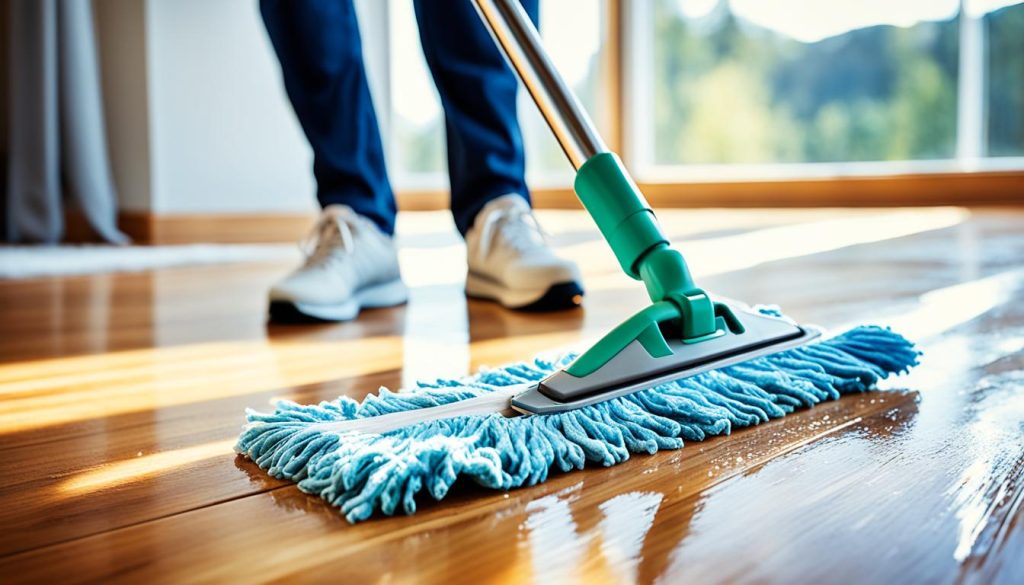
Proper mopping techniques are essential for maintaining clean and beautiful hardwood floors.
Addressing Scratches and Scuffs
Scratches and scuffs can detract from the beauty of hardwood floors. To maintain the overall appearance of your floors, it is important to address them promptly.
For minor scratches, a stain marker or wax stick from a wood furniture touch-up kit can be used. Gently apply the marker or wax stick to the scratched area, following the manufacturer’s instructions. This will help conceal the scratch and blend it in with the surrounding wood.
Deeper dents may require a slightly more involved process. Start by sanding the damaged area with fine-grit sandpaper, moving in the direction of the wood grain. Remove any excess dust and apply a small amount of matching stain to the sanded spot. Once the stain has dried, apply a coat of polyurethane to restore shine and protect the repaired area.
If the damage to your hardwood floors is more extensive or if your floors require refinishing, it is advisable to consult a professional wood flooring specialist. They will have the expertise to assess the damage and recommend the best course of action, whether it involves sanding, refinishing, or replacing individual boards.
FAQ
How often should I sweep my hardwood floors?
It is recommended to sweep your hardwood floors daily to remove dirt and debris, focusing on high-traffic areas.
What should I use to dry mop my hardwood floors?
After sweeping, use a dry mop or dust mop to pick up any remaining dirt. Using a microfiber mop can help maintain the luster of your hardwood floors and minimize scuffs.
How often should I vacuum my hardwood floors?
Regular vacuuming is essential for thorough cleaning. Use a vacuum cleaner with a hard floor setting and ensure that the brush roll or beater bar is turned off or use a flat attachment to protect the floor from bristles.
How do I mop my hardwood floors?
Use a wood floor cleaner and a damp microfiber mop to mop your hardwood floors. Avoid excess water, as standing water can cause the wood to swell and potentially damage the floors.
Can I use a steam mop on my hardwood floors?
It is advisable to avoid using steam and steam mops on hardwood floors, as the vapor can enter small spaces and damage the wood.
How do I address scratches and scuffs on my hardwood floors?
For minor scratches, use a stain marker or wax stick from a wood furniture touch-up kit. Deeper dents may require sanding the area with fine-grit sandpaper, applying a small amount of stain, and adding a coat of polyurethane for shine. For extensive damage or refinishing needs, consult a professional wood flooring specialist.



